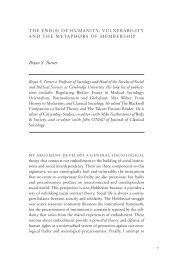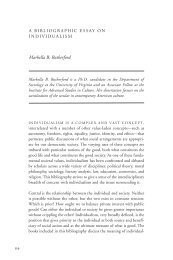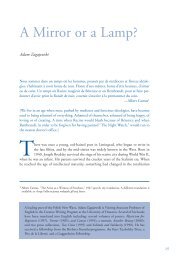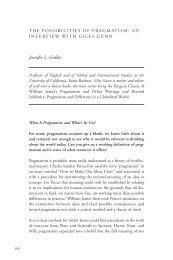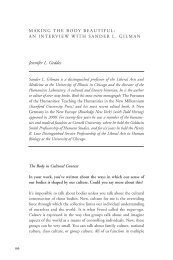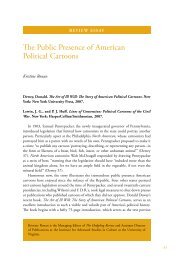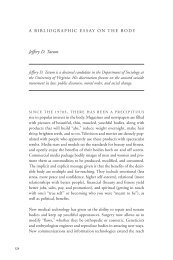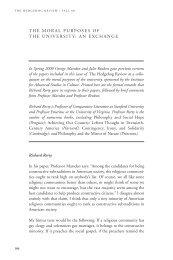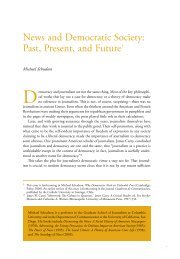ambiguous distinctions - Institute for Advanced Studies in Culture
ambiguous distinctions - Institute for Advanced Studies in Culture
ambiguous distinctions - Institute for Advanced Studies in Culture
Create successful ePaper yourself
Turn your PDF publications into a flip-book with our unique Google optimized e-Paper software.
add a roommate, girlfriend, or cous<strong>in</strong>. While most<br />
observers marvel over the relational cornucopia that<br />
these sites create, what is more strik<strong>in</strong>g is the fact<br />
that celebrities, rock stars, and one’s social <strong>in</strong>timates<br />
can exist side-by-side on a Friends list with little or<br />
no dissonance. A banality of friendship is designed<br />
<strong>in</strong>to the functions of these sites. Its easy acceptance<br />
suggests that young Americans are both amenable to<br />
a “th<strong>in</strong>n<strong>in</strong>g out” of personal relationships and a “thicken<strong>in</strong>g” of<br />
ties to public figures conventionally encountered through the<br />
mass media. In this way, Friends lists publicly articulate and<br />
re<strong>in</strong><strong>for</strong>ce the contemporary experience of “pseudo-community,”<br />
the illusion of relationship that media audiences feel with<br />
television talk-show hosts, movie stars, and other celebrities.<br />
The success of social-network<strong>in</strong>g sites also suggests that young<br />
Americans are com<strong>for</strong>table approach<strong>in</strong>g their personal relationships<br />
<strong>in</strong> the mode of consumer. Facebook’s “News Feed”<br />
feature, <strong>for</strong> example, keeps users up-to-date on each of their<br />
Friends’ onl<strong>in</strong>e behaviors: who has posted on whose page,<br />
who has removed whom from their Friends list, and who has<br />
jo<strong>in</strong>ed which group. Users can even keep track of the status<br />
of their Friends’ chang<strong>in</strong>g romantic relationships. The options<br />
<strong>in</strong>clude “s<strong>in</strong>gle,” “<strong>in</strong> a relationship,” “engaged,” “married,” or (my<br />
personal favorite) “it’s complicated.” With celebrities and close<br />
friends occupy<strong>in</strong>g the same social space, the daily practice of<br />
“keep<strong>in</strong>g up” with one’s Friends’ profiles shares a disconcert<strong>in</strong>g<br />
similarity with “keep<strong>in</strong>g up” with the news on MSNBC<br />
or a Yahoo! page. As the ma<strong>in</strong>tenance of social relationships<br />
becomes primarily a <strong>for</strong>m of <strong>in</strong><strong>for</strong>mation management, friendships<br />
easily shade <strong>in</strong>to a <strong>for</strong>m of consumption. Individuals, <strong>in</strong><br />
turn, update their profiles and “produce” their identities onl<strong>in</strong>e<br />
<strong>for</strong> the express purpose of be<strong>in</strong>g consumed <strong>in</strong> this fashion. As<br />
with many other contemporary social practices, where the<br />
private and public blur together, the value of <strong>in</strong>timacy decl<strong>in</strong>es<br />
and the consumer role is amplified.<br />
F<strong>in</strong>ally, social-network<strong>in</strong>g sites may have last<strong>in</strong>g consequence<br />
because their very design articulates what sociologist Barry<br />
Wellman has long argued: the local community is no longer<br />
a mean<strong>in</strong>gful category <strong>for</strong> many Americans. While we are<br />
clearly embodied be<strong>in</strong>gs, the salience of physical location has<br />
dim<strong>in</strong>ished <strong>in</strong> how contemporary Americans th<strong>in</strong>k about and<br />
function <strong>in</strong> their social lives. The best way to describe contemporary<br />
sociability is <strong>in</strong> terms of “networked <strong>in</strong>dividualism,”<br />
overlapp<strong>in</strong>g networks of social ties that have <strong>in</strong>dividuals at the<br />
The success of social-network<strong>in</strong>g sites<br />
also suggests that young Americans are<br />
com<strong>for</strong>table approach<strong>in</strong>g their personal<br />
relationships <strong>in</strong> the mode of consumer.<br />
core of each. People understand “community” <strong>in</strong> terms of multiple<br />
systems of friends, contacts, and acqua<strong>in</strong>tances that span<br />
time and place—but are oriented around each <strong>in</strong>dependent<br />
self. Uses of other technologies, such as cell phones, re<strong>in</strong><strong>for</strong>ce<br />
this dynamic. People make more and more calls not to places<br />
or households, but to <strong>in</strong>dividuals, quite apart from their physical<br />
location.<br />
In Sources of the Self, the philosopher Charles Taylor meticulously<br />
documents the trans<strong>for</strong>mation of personal identity<br />
<strong>in</strong> Western civilization over the past two hundred years. He<br />
argues that the sources of self-identity have shifted from<br />
external and transcendent referents to the <strong>in</strong>ternal and subjective<br />
experience of the <strong>in</strong>dividual. Other scholars, like Robert<br />
Putnam and Adam Seligman, make similar arguments about<br />
the decl<strong>in</strong>e of community as an orient<strong>in</strong>g feature of people’s<br />
lives. That many operate as though the sources of personal<br />
identity are with<strong>in</strong> the <strong>in</strong>dividual self is strongly suggested by<br />
the popularity and easy adoption of social-network<strong>in</strong>g sites.<br />
There, networks radiate out from the center—a center that is<br />
not a location, a cause, or a common identity, but simply the<br />
<strong>in</strong>dividual. Sites operate on the presupposition that users are<br />
com<strong>for</strong>table orient<strong>in</strong>g their social lives around themselves.<br />
And so, it seems, they are, as young Americans easily recast<br />
pre-exist<strong>in</strong>g relationships and practices of sociability accord<strong>in</strong>g<br />
to site prerequisites. While the cultural changes that make this<br />
adaptability possible have been long <strong>in</strong> the mak<strong>in</strong>g, it may be<br />
that as late-modern <strong>in</strong>dividuals, we have f<strong>in</strong>ally begun to create<br />
social <strong>in</strong>stitutions that reflect and re<strong>in</strong><strong>for</strong>ce basic dispositions<br />
towards networked <strong>in</strong>dividualism and consumption <strong>in</strong> the <strong>in</strong>timate<br />
sphere. What is so remarkable about social-network<strong>in</strong>g<br />
sites is not, then, how much they change the landscape of<br />
contemporary social life, but rather how well they succeed <strong>in</strong><br />
reflect<strong>in</strong>g its essential dynamic.



